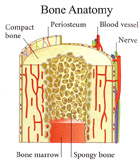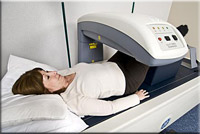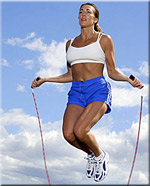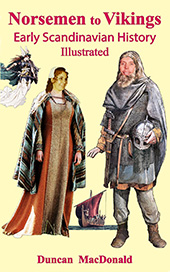Osteoporosis |
Duncan MacDonald
Jakarta 10 March 2007
What is Osteoporosis 
Osteoporosis literally means 'porous bones'. Our bones are made up of a thick outer shell and a strong inner honeycomb mesh of tiny struts of bone. When we develop osteoporosis some of these struts become thin or break. This makes the bone thinner, brittle, more fragile, and prone to break. It often remains undetected until the first broken bone. Broken wrists, hips and spinal bones are the most common fractures in people with osteoporosis.
What are the causes?
Two types of cells are constantly at work in our bones. One set builds up new bone, while another set breaks down old bone. Up to our mid-20's the construction cells work harder building strength into our skeleton.From our 40's onward, the demolition cells overtake and our bones gradually loose density as a natural part of aging. [ 1 ]
Sex hormones are necessary for bone replacement. In both men and women, osteoporosis begins to develop as sex hormone production declines with age.
In women, production of the sex hormone oestrogen declines rapidly after menopause. Early menopause, which tends to occur in women who smoke, increases the risk of osteoporosis.

In men, untreated hypogonadism (Underactivity of the testes, resulting in low levels of the sex hormone testosterone and impaired production of sperm) results in low bone density early in life. [ 2 ]
Osteoporosis may also occur as a result of long-term treatment with oral corticosteroids (drugs used to treat inflammatory conditions that affect the joints, skin, digestive tract, respiratory system, eyes and ears). People with rheumatoid arthritis, an overactive thyroid gland or chronic kidney failure are also at risk of osteoporosis.
White and Asian women, especially those who have a slight build or have an eating disorder are at increased risk. Osteoporosis sometimes runs in families. Women who have a close relative with osteoporosis are more likely to develop it themselves.
Can it be prevented?
Measures to prevent osteoporosis started early in life are most effective. Teenagers and young adults should eat a balanced diet rich in calcium and vitamin D and maintain it throughout life. Calcium is essential for bone strength and vitamin D aids calcium absorption in the body.Extra calcium is needed during pregnancy, while breast feeding and during and after menopause. Vitamin D is also produced in the skin in response to sunlight. People exposed to little sunlight may need vitamin D supplements.

Walking and other weight-bearing exercises help to increase bone density. Tennis players, for example have a 30% higher bone density in their serving arm than their non-serving arm. Not smoking and limiting alcohol intake also reduces the risk of osteoporosis.
Women may be encouraged to use hormone replacement therapy (HRT) during and after menopause, which may help to protect against osteoporosis, however there is no medical consensus on how long it should be continued. Significant risks are associated with HRT including a doubling the risk of breast cancer, and increased risk of heart disease and stroke.
Selective estrogen receptor modulators (SEMS) are a new type of drug that acts like a synthetic form of hormone replacement. They reduce the risk of osteoporosis and heart attacks but don't increase the risk of breast cancer. [ 3 ]

What are symptoms?
Some physical changes associated with aging are in fact due to osteoporosis. They include;• Gradual loss of height
• Rounding of the back
The first evidence of osteoporosis for many people is a painful fracture of a bone after minor stress or injury.
What might be done?
Your medical doctor can make a diagnosis from your medical history and tests involving a bone densitometer or Dual X-ray Absorptiometry (DXA). At present it is the most accurate and reliable means of assessing bone strength. DXA machines usually scan some bones in the lower spine and one hip, two of the main areas at risk from osteoporosis fractures.
and one hip, two of the main areas at risk from osteoporosis fractures.
This technique uses a radiation dose, which is similar to the natural background radiation, less than 1/10th of the dosage of a chest x-ray. The DXA scan will take up to 20 minutes and is not in any way unpleasant.
It involves lying on a firm couch whilst an arm passes over the body taking an image of the spine and hips. It does not involve being enclosed in a mechanical tunnel or having an injection. Generally clothing does not have to be removed although clothes with metal at the hips or along the spine should be avoided. Trouser zips are not a problem.
Blood tests to exclude other causes of symptoms, such as Osteomalacia and Rickets (disorders due to lack of vitamin D resulting in weak, soft bones that become distorted or fracture easily) and Paget's disease of the bone (a disorder of bone maintenance and repair, leading to weakened, distorted and occasionally painful bones) – more common in males over 50.
Conclusion 
The most important thing you can do to prevent osteoporosis developing is keep bones strong and healthy while you're young. The aim is to maximise peak bone mass, reached at the end of your 20's. [ 4 ]
Try running or cycling for 30 minutes a day, three times a week. Simply jumping up and down 50 times a day will keep your bones strong.
Factors that can help maintain healthy bones are a well balanced diet with adequate calcium rich foods, regular weight bearing exercise, avoid smoking and keep alcohol consumption within recommended limits.




